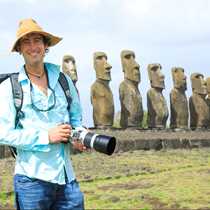As the sun rises over the bow of the National Geographic Endeavour, we drop the anchor in front of San Cristobal Island. For our guests, this beautiful sight is met with an ounce of sadness, as it is the last day of our week in paradise among the Galapagos Islands. We split into 2 groups for this morning’s outings, one to enjoy a beautiful Zodiac ride photographing iconic sea birds like the Red Footed Booby, and the second group will hike to a scenic plateau. We land on the beautiful golden beach, and we are immediately impressed by the shimmering sand. As we hike up the dry riverbed, we are greeted by a San Cristobal Lava lizard on almost every boulder. These lizards are endemic not only to Galapagos, but endemic to this island, and found nowhere else on earth. The photogenic females have a golden hue and a vibrant red belly.
Reaching the plateau, we enjoy the cool ocean breeze and take in the views of the blue ocean below. We move to the eastern edge where we find our first red footed boobies nesting only 20 feet below. One proud parent leans back revealing an egg. Their turquoise beaks reflect the morning light, and we get nice views of them flying with the vibrant red sesuvium plants below. On our return, we catch a rare sighting of five goats walking on the peak ahead. After traveling among these islands since 2009, this is actually my first sighting of goats in the wild. It reminds us that while we’ve successfully eradicated this invasive introduced species on other islands, we still have a lot of work to do to finish the job on the rest of the islands.
After returning to the beach, we are greeted by our playful and charismatic friends, a pair of young Galapagos Sea Lions. 6 of our young explorers are playing in the water, and the friendly pair of sea lions join in the fun. They do flips through the water, and I leap to my feet to photograph their interactions. These are the memories that we hope will never fade in our travelers. Galapagos has changed my life in many ways, and through the teachings of the animals and the naturalists, today I feel a tremendous connection with these animals.
The afternoon is upon us and we load into the Zodiacs for one more adventure. We aim our Zodiac towards one of my favorite places in Galapagos—the famous Leon Dormido. This volcanic formation is a stunning view from above, but we seek a greater thrill, the animals below. While most of the world fears sharks, here we can find them only a meter away, and we realize our fears are unwarranted. The Galapagos is famous for offering some of the world’s best opportunities to swim with sharks in absolute safety. These animals are peaceful, graceful, and honestly far safer than a kitten. Minutes into the swim I find a beautiful Pacific green sea turtle who lets me accompany her for what seems like five minutes. I see two sharks, a juvenile Galapagos shark and black tipped reef shark. Then I see it—the most beautiful animal in Galapagos, which we see on the national park emblem, the mighty hammerhead shark. I am always transfixed by their grace. It is a beautiful individual, five feet long, and continues on unfazed by my presence. I take a few pictures before returning to the surface. As it vanishes into the blue, my eye catches a light patch in the water shaped like a big triangle. While faint, it is the unmistakable face of a spotted eagle ray. I take another big breath, and while I descend, I find he’s not alone, but in fact there are eight of them.
Back on the surface, I find my seven year old buddy Colin swimming along with his dad. A week ago Colin walked through the airport carrying a three foot stuffed animal resembling a black tipped reef shark. I learned he was filming sharks when he was only six years old. I hope his friends back home will be excited when they hear of his adventures with sharks. Sharks are spectacular animals, and they need a lot more people like Colin to share their beauty with the world.




